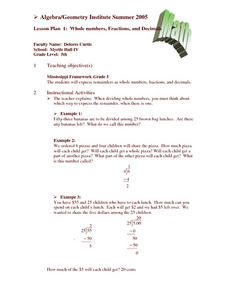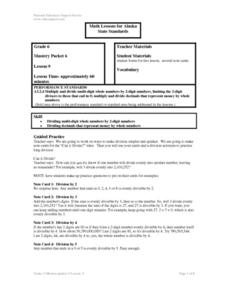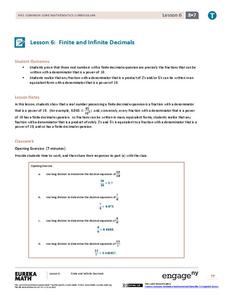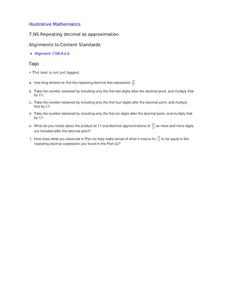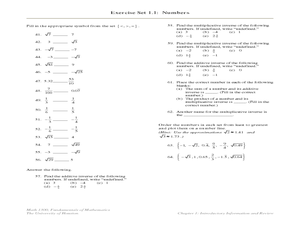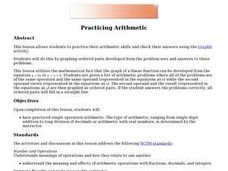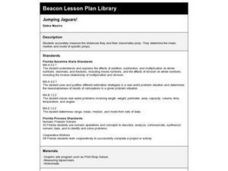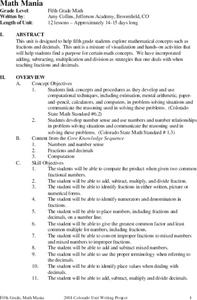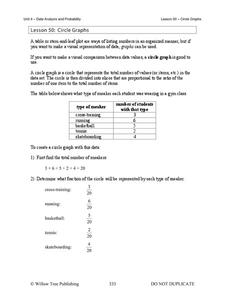EngageNY
Converting Rational Numbers to Decimals Using Long Division
Convert fractions that cannot be written with a denominator that is a power of 10. Pupils use the definition of a fraction and long division to convert fractions to decimals, then discover that some divisions terminate and others...
EngageNY
The Long Division Algorithm
Two methods are always better than one! The eighth installment in this series asks pupils to convert decimals to fractions using two approaches. Individuals first use the more traditional approach of long division and then use reverse...
Curated OER
Whole Numbers, Fractions, and Decimals
Elementary and middle schoolers participate in an assignment to explore the concept of division and having a remainder. They also practice division problems using decimals and fractions without a remainder.
National Education Support Service
Division Note Cards
Sixth graders create note cards to divide multi-digit whole numbers by two-digit numbers and divide decimals that represent money by whole numbers in a simpler and faster fashion. They write the rules and examples of each on the cards...
Illustrative Mathematics
Equivalent fractions approach to non-repeating decimals
Trying to get your class to think of decimals as fractions and vice versa can lead to interesting discussions. After all, we can usually understand quickly that 1/4 is .25 but why is 1/7 not so easy to convert? This activity looks...
EngageNY
Finite and Infinite Decimals
Explore the patterns of fractions that produce finite and infinite decimals. The sixth lesson of the series asks learners to determine a similar feature of fractions that produce finite decimals. Using the patterns, pupils create...
Curated OER
Relating Fractions and Decimals
Sixth graders identify how fractions and decimals both illustrate parts of a whole. They estimate which number is greater by comparing them to the given fraction and use greater than or less than symbols for each.
EngageNY
Decimal Expansions of Fractions, Part 2
Develop your pupils' understanding of fractions and their decimal equivalence using the 12th lesson in this series. Scholars learn an alternative to long division that results in converting fractions to decimals that emphasize fractional...
Curated OER
Repeating Decimal as Approximation
You are used to teaching repeating decimals with bar notation that keeps us from writing that number over and over again; now teach what the over and over again represents. This activity allows your mathematicians to explore the infinite...
Region of Peel
Put Me in Order
Sorting fractions, integers, decimals and square roots into sequential order is an active process when you use a gym as your setting. After your class is divided into two groups and provided with number cards, they compete to see who can...
Curated OER
Adding and Subtracting Decimals
Fourth graders develop the concept of adding and subtracting decimals. In this decimal lesson plan, they participate in a teacher directed demonstration of how to add and subtract decimals. They work in teams as each person performs one...
Curated OER
Fractions to Decimals
Seventh graders play a game to practice converting fractions into decimals. Students begin by practicing their conversions through guided practice. After being divided into teams, 7th graders practice their conversions by playing a...
Curated OER
Fractions To Decimals
Middle schoolers investigate the concept of converting fractions to decimals with the use of practice in recognition of fractions and finding the decimal equivalent by sight or by using division. This instructional activity could be done...
Curated OER
Numbers 1.1
In this numbers 1.1 worksheet, pupils solve 64 problems about all kinds of numbers: rational, irrational, prime, composite, square roots, fractions, decimals.
Curated OER
Practicing Arithmetic
Students practice single operation arithmetic ranging from single digit addition to long division of decimals or real numbers using Graphit. They use data sets and rules to graph ordered pairs.
Curated OER
Jumping Jaguars!
Second graders accurately measure the distances they and their classmates jump. They determine the mean, median and mode of specific jumps. They are required to have two measurements for each classmate, one for standing long jump and one...
Curated OER
Math Mania
Fifth graders review adding, subtracting, multiplication and division of fractions and decimals through a variety of activities and exercises.
Curated OER
Savings
Students investigate the different ways to save money and the reasons for doing so. They use addition, subtraction, multiplication, and division (with whole numberrs, fractions, decimals, and/or percents, mixed numbers) to solve...
Willow Tree
Circle Graphs
Pie isn't just for eating! Scholars learn to create pie charts and circle graphs to represent data. Given raw data, learners determine the percent of the whole for each category and then figure out the degree of the circle that percent...
Curated OER
Claire Damarodas
Fifth graders examine how sugars may be listed as an ingredient in various ways. E.g. Many of the words end in -ose (ex. Sucrose, dextrose, maltose)
Curated OER
Horatio's Ratios
View a PBS video entitled Horatio's Drive and explore Horatio's Ratios. Collaborative learners form groups to use Mapquest to determine distances covered. They generate the mathematical averages, ratios, and rates in order to calculate...
Ohio Department of Education
Actions with Fractions: Adding and Subtracting Fractions with Common Denominators
Fourth graders develop a conceptual understanding of fractions and begin to add and subtract fractions with like denominators. Included is a worksheet to assess readiness and a teacher's checklist showing class understanding at a...
Curated OER
A Trip to Colonial Virginia
Students consider prices while planning a trip to Colonial Virginia. In this budgeting lesson, students construct an itinerary of events for a vacation. Students are responsible for working within the approved budget.
Curated OER
Multiplying by 3
Second graders practice the multiples of three as an introduction to multiplying by three.


